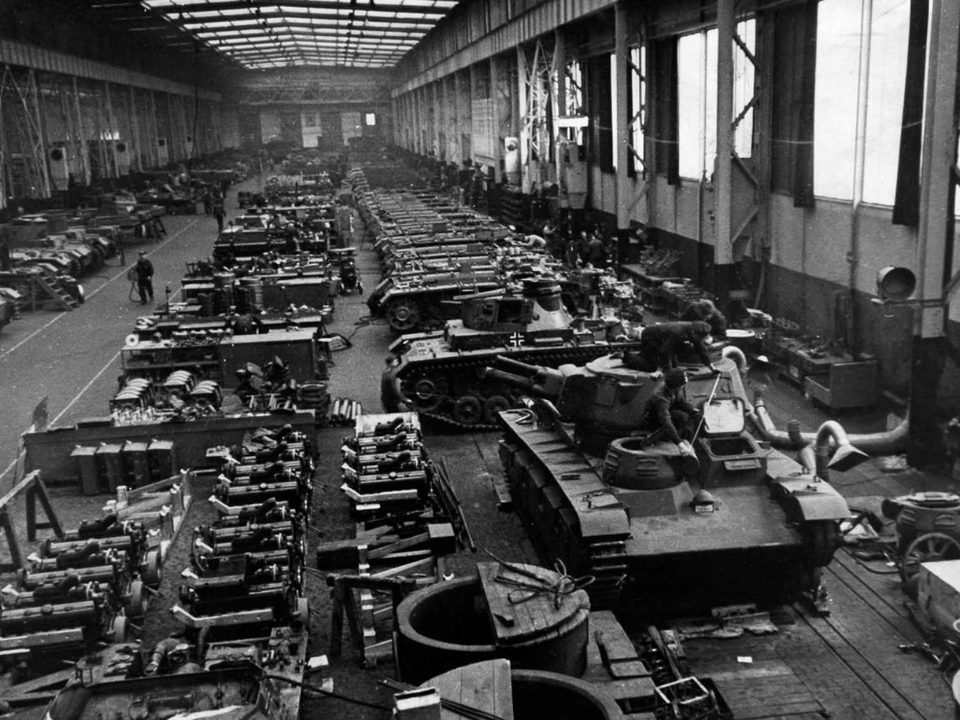Unveiling the Engine of Aggression: How Nazi Germany Mobilized Industry and Innovation for Total War
For Reference: Nazi Germany | Part 4
As the Nazi regime tightened its grip on Germany, its focus shifted toward militarization and economic transformation. This article explores the rise of the military-industrial complex in Nazi Germany, detailing how the regime aligned its economy, technological advancements, and industrial power to prepare for war. The collaboration between the state and major corporations, the rearmament programs, and the relentless drive for autarky (self-sufficiency) all played pivotal roles in creating one of the most formidable war machines of the 20th century.
Economic Revival and the Seeds of Militarization
The Nazi regime inherited a nation crippled by the Great Depression. Unemployment was rampant, and public confidence in the government was at an all-time low. Adolf Hitler and his economic advisors, including Hjalmar Schacht, introduced policies that focused on public works programs and rearmament to jumpstart the economy. Projects like the construction of the autobahns served as propaganda victories while subtly laying the groundwork for military logistics.
The Reichswerke Hermann Göring, a state-owned industrial conglomerate, was created to dominate industries critical to war, such as steel and armaments. These efforts were bolstered by the regime’s manipulation of financial policies, including deficit spending and the secret Mefo bills, which funded rearmament under the guise of infrastructure development.
Rearmament and the Break from the Versailles Treaty
One of Hitler’s earliest priorities was rearmament, a direct violation of the Treaty of Versailles. The establishment of the Wehrmacht in 1935 signified a bold step toward building a modern military force. German industry became a critical partner in this endeavor. Companies like Krupp, IG Farben, and Daimler-Benz thrived under lucrative government contracts, producing tanks, aircraft, and ammunition on an unprecedented scale.
The Luftwaffe, Germany’s air force, emerged as a symbol of the nation’s technological prowess. Meanwhile, the navy (Kriegsmarine) embarked on ambitious projects such as the construction of U-boats, which would later play a key role in the Battle of the Atlantic.

Image: World War Photos
Technological Advancements and War Innovation
Nazi Germany’s military-industrial complex was driven by cutting-edge research and innovation. Scientists, engineers, and industrialists collaborated to develop weapons that would give Germany a strategic advantage. Some notable advancements included:
Rocketry: The V-2 rocket, developed by Wernher von Braun and his team, became the world’s first long-range guided ballistic missile, showcasing Germany’s technological edge.
Panzer Tanks: The development of Panzer tanks, such as the Panzer IV and later the Tiger tanks, revolutionized armored warfare.
Jet Aircraft: Germany pioneered jet propulsion with the Messerschmitt Me 262, the world’s first operational jet-powered fighter aircraft.
These innovations were complemented by ruthless exploitation of occupied territories and forced labor, which became central to sustaining the war effort.
The Role of Forced Labor and Economic Exploitation
As Nazi Germany expanded across Europe, the regime systematically exploited the resources and labor of conquered nations. Millions of civilians and prisoners of war were forced into labor under brutal conditions, fueling the German war machine. Industries like IG Farben and Siemens used forced labor to meet production demands, making them complicit in the atrocities of the regime.
The looting of occupied territories extended beyond labor. The Nazis plundered raw materials, food, and industrial equipment, draining the economies of their victims to sustain their own.
Autarky and the Four-Year Plan
The Nazis pursued autarky, aiming for self-sufficiency to prepare for prolonged conflict. Under Hermann Göring’s leadership, the Four-Year Plan focused on reducing dependence on foreign imports and increasing the production of synthetic materials, such as rubber (Buna) and fuel. This policy underscored the regime’s determination to prepare for total war, even at the expense of economic stability.
The Legacy of Militarization
Nazi Germany’s military-industrial complex was a double-edged sword. While it enabled the regime to wage war on an unprecedented scale, it also overstretched the economy, leading to eventual collapse. The exploitation of human and natural resources left deep scars on Europe, and the ethical breaches of forced labor and collaboration with industry remain subjects of intense scrutiny.
The militarization of Nazi Germany reveals the terrifying efficiency of a regime that combined economic policy, industrial might, and technological innovation to prepare for war. It serves as a cautionary tale about the dangers of unchecked militarism and the complicity of industry in state-led aggression. Understanding this chapter of history is essential to recognizing the interplay between politics, economics, and warfare in shaping the modern world.
Details of the Featured Image
This image captures a German tank factory in 1940, showcasing the industrial scale at which Nazi Germany produced armored vehicles during World War II.
Image: Rare Historical Photos
Author
Ziara Walter Akari
© www.apotheosislife.com
